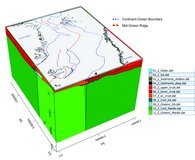The lithospheric structure of passive continental margins does not only reflect their geodynamic evolution from the rifting stage to oceanic break-up and seafloor spreading, but also controls their present-day thermomechanical configuration, both aspects being critical for the assessment of geological hazard and resource potentials. We investigate the present-day crustal and upper mantle structure of the North East Atlantic (NEA) region which encompasses the conjugate passive margins of Greenland and Norway/Svalbard as well as the North Atlantic Ocean which is aged ≤65 Ma and interacting with the Iceland Plume. Going beyond the mere analysis of seismic profiles across the margins, we develop a lithospheric-scale 3D model of the entire region by integrating various geological and geophysical observations, including the gravity field. The derived 3D geological model allows us to causatively relate regionally traceable tectonic structures to the geodynamic evolution of the NEA and, by means of numerical simulations, investigate the thermomechanical behavior of first-order crustal and mantle lithospheric heterogeneities under evolving (e.g., climate controlled) stress conditions.
As a result of an extensive industry-driven exploration for hydrocarbon and geothermal energy, accompanied by decades of academic research in the area, there is a vast availability of geological and geophysical data ready to be analyzed and integrated into a consistent 3D model. For this purpose, we combine different modelling tools and techniques. We use the software Petrel (©Schlumberger) to visualize and collectively analyse reflection and refraction seismic profiles, seismic tomography models as well as depth and thickness information from previously published 3D models of sub-regions. To mitigate insufficient coverage of data in parts of the region and consistently link shallow crustal with deeper mantle lithosphere structures, we perform 3D gravity modelling (using the software IGMAS+). Considering that the density of the mantle lithosphere is strongly controlled by temperature, we obtain its density configuration by combining temperatures as derived from seismic tomography models and from calculations of the 3D steady-state conductive thermal field (software GOLEM). Furthermore, we invert gravity residuals (i.e. modelled minus observed gravity anomalies) to obtain the depth position of the interface between the upper and the lower continental crust using the Harvester module of Fatiando a Terra. Hence, the finally obtained 3D model resolves first-order density heterogeneities of the sedimentary cover, the crust and the mantle lithosphere. The envisaged heat transport and thermomechanical simulations will be based on corresponding lithological differences of the model units.
Contribution to: POF IV: Topics 3 “Geohazards” and 8 “Georesources”
Partners:
• Prof. Dr. Jan Inge Faleide - Centre for Earth Evolution and Dynamics (CEED). Department of Geosciences, University of Oslo, Norway.
• Dr. Mansour Abdelmalak - Centre for Earth Evolution and Dynamics (CEED). Department of Geosciences, University of Oslo, Norway.
Funding: Advanced Earth System Modelling Capacity project (ESM)
Publications:
Gomez Dacal, M. L.; Faleide, J. I.; Abdelmalak, M.; Scheck-Wenderoth, M.; Anikiev, D.; and Meeßen, C. (2020). 3D lithospheric structure and density of the NE Atlantic. EGU General Assembly 2020, Online. EGU2020-18271, doi.org/10.5194/egusphere-egu2020-18271.
Contribution to: POF IV: Topics 3 “Geohazards” and 8 “Georesources”
Partners:
Prof. Dr. Jan Inge Faleide - Centre for Earth Evolution and Dynamics (CEED). Department of Geosciences, University of Oslo, Norway.
Dr. Mohamed Mansour Abdelmalak - Centre for Earth Evolution and Dynamics (CEED). Department of Geosciences, University of Oslo, Norway.
Funding:
Advanced Earth System Modelling Capacity project (ESM)
Publications:
Gomez Dacal, M. L.; Faleide, J. I.; Abdelmalak, M.; Scheck-Wenderoth, M.; Anikiev, D.; and Meeßen, C. (2020). 3D lithospheric structure and density of the NE Atlantic. EGU General Assembly 2020, Online. EGU2020-18271, doi.org/10.5194/egusphere-egu2020-18271.






